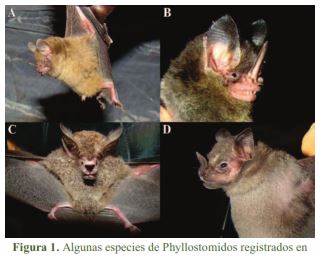Abstract
With a total of 9,120 m-network / hrs of sampling effort, 87 records belonging to 15 species from four subfamilies were obtained (Figure 1). The most diverse subfamila was Phyllostominae with six species, followed by Carollinae and Stenodermatinae with four species respectively, and the least representative was Glossophaginae, with only one record.
References
AGUIRRE, L.F. et al. 2009. Clave de campo para la identificación de los murciélagos de Bolivia. Centro de Estudios en Biología Teórica y Aplicada. Cochabamba, Bolivia.
AVILA-CABADILLA, L.D. et al. (2009). Composition, structure and diversity of phyllostomid bat assemblages in different successional stages of a tropical dry forest. Forest Ecology and Management 258(6):986-996.
BERNARD, E. 2001. Vertical stratification of bat communities in primary forests of Central Amazon, Brazil. Journal of Tropical Ecology 17(01):115-126.
FENTON, M.B., et al. 1992. Phyllostomid bats (Chiroptera: Phyllostomidae) as indicators of habitat disruption in the Neotropics. Biotropica. 24:440-446.
FLEMING, T.H. & V.J. SOSA. 1994. Effects of nectarivorous and frugivorus mammals on reproductlve: succcss of plants. Jounal of Mammalogy. 75:845-851.
GALINDO-GONZALES, J. 1998. Dispersión de semillas por murciélagos: su importancia en la conservación y regeneración del bosque tropical. Acta Zoológica Mexicana 1(073):55-74.
ISAZA, C. et al. 2013. Manejo actual de Mauritia flexuosa para la producción de frutos en el sur de la Amazonia colombiana. Pp. 243-273 en: Morichales y canangunchales de la Orinoquia y Amazonia: Colombia – Venezuela (Lasso, C, et al eds), Instituto de Investigación de los Recursos Biológicos Alexander von Humboldt (IAvH).
JIMÉNEZ-ORTEGA, A.M. 2013. Conocimiento y conservación de los murciélagos filostómidos (Chiroptera: Phyllostomidae) y su utilidad como bioindicadores de la perturbación de los bosques neotropicales. Tesis de Doctorado, Universidad Autonoma de Madrid.
KALKA M.B., et al. 2008. Bats limit arthropods and herbivory in a tropical forest. Science 320:71
KALKO, E.K.V. et al. 1996. Organization, diversity and long-term dynamics of a Neotropical bat community. En: Long-term studies of vertebrate communities. (Cody M. L. & J. A. Smallwood eds.). Academic Press, San Diego
KALKO, E.K.V. 1997. Diversity in tropical bats. Pp.13-43 en: Tropical biodiversity and systematics. Proceedings of the International Symposium on Biodiversity and Systematics in Tropical Ecosystems, Bonn 1994 (Ulrich, H. ed). Zoologisches Forschungsinstitut und Museum Alexander Koenig, Bonn.
KAHN, F. et al. 1993. Mauritia flexuosa (Palmae): La más acuática de las palmeras amazónicas. En: Las plantas vasculares en las aguas continentales del Perú. (Kahn, F. et al. eds.), IFEA.
LIM, B.K. & M.D. ENGSTROM. 2001. Bat community structure at Iwokrama Forest, Guyana. Journal of Tropical Ecology 17:647-665.
MANTILLA-MELUK, H. et al. 2009. Phyllostomid bats of Colombia: Annotated Checklist, Distribution, and Biogeography. 56th ed. Special Publications of the Museum of Texas Tech University.
MATAPÍ, U. et al. 2013. Los cananguchales, el mundo de la boa y los peces: visión Upichía (Matapí) de las áreas inundables en la Amazonia colombiana y su conservación. Pp. 277-287 en: Morichales y canangunchales de la Orinoquia y Amazonia: Colombia – Venezuela (Lasso, C, et al. eds.), Instituto de Investigación de los Recursos Biológicos Alexander von Humboldt (IAvH).
MUÑOZ, J. 2001. Los murciélagos de Colombia. Sistemática, distribución, descripción, historia natural y ecología. Editorial Universidad de Antioquia. Medellín.
RUIZ, S. L., et al. (eds.). 2007. Diversidad biológica y cultural del sur de la Amazonia colombiana - Diagnóstico. Bogotá-Colombia: Corpoamazonia, Instituto Humboldt, Instituto Sinchi, UAESPNN.
SOLARI, S., et al. 2012. Riqueza, endemismo y conservación de los mamíferos de Colombia, Mastozoologia Neotropical 20(2):301-365
TUNM, R. et al. 1999. Clave de campo para los murciélagos de Costa Rica. Brenesia 52:1-32.
WILLIG, M.R., et al. 2007. Phyllostomid bats of lowland Amazonia: effects of habitat alteration on abundance. Biotropica 39(6):737-746.
WETTERER, A.L, et al. 2000. Phylogeny of phyllostomid bats (Mammalia: Chiroptera): data from diverse morphological systems, sex chromosomes, and restriction sites. Bulletin of the American Museum of Natural History 248:1–200.
WUNDERLE JR, J. M. 1997. The role of animal seed dispersal in accelerating native forest regeneration on degraded tropical lands. Forest Ecology and Management 99(1-2):223-235.

This work is licensed under a Creative Commons Attribution-ShareAlike 4.0 International License.





